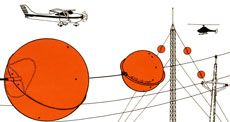 Ok, moving the camera just slightly to the right, what do we see?
Ok, moving the camera just slightly to the right, what do we see?There is a string of telephone wires, but in front of that there are also some orange and white towers - you can just see them barely taller than the treeline. I have not had any luck finding out what exactly they are - radio reception towers most likely.
The orange and white paint scheme is a sure giveaway that you're near an airport. The aviation world has adopted these
 colors to promote awareness and safety. I'm sure you've seen those orange balls on the telephone wires before. Picture to left from Tana Wire Markers: Mark power lines, communication antennas, and guy wires at airport or helicopter areas, river and canyon crossings, overhead obstruction areas, construction sites, migratory waterfowl refuge areas, bird diversion, and more!
colors to promote awareness and safety. I'm sure you've seen those orange balls on the telephone wires before. Picture to left from Tana Wire Markers: Mark power lines, communication antennas, and guy wires at airport or helicopter areas, river and canyon crossings, overhead obstruction areas, construction sites, migratory waterfowl refuge areas, bird diversion, and more!There is a whole FAA ADVISORY CIRCULAR AC 70/7460-1K on Obstruction Marking and Lighting. It says any temporary or permanent structure, including all appurtenances, that exceeds an overall height of 200feet (61m) above ground level (AGL) or exceeds any
obstruction standard contained in 14 CFR part 77, should normally be marked and/or lighted. It also specifies the patterns that objects should be painted in, for example:
a. Solid Pattern. Obstacles should be colored aviation orange if the structure has both horizontal
and vertical dimensions not exceeding 10.5 feet (3.2m).
b. Checkerboard Pattern. Alternating rectangles of aviation orange and white are normally displayed on the following structures:
1. Water, gas, and grain storage tanks.
2. Buildings, as required.
3. Large structures exceeding 10.5 feet (3.2m) across having a horizontal dimension that is equal to or greater than the vertical dimension.
Don't worry, I won't reproduce the whole manual here - it is extensive! If one had the time, they could know what size an obstruction is just by the type, location and intensity of the lights...






































 Stationed at Barron Field, Texas, Pilot Cadet Locklear started climbing out onto his Jenny biplane's lower wing while in mid-air to resolve certain problems. His first trip out onto his wing occurred when he could not see some communications clearly that were being flashed at him from the ground because the plane's engine housing and wing were blocking his view. Because he needed to interpret the communication to pass one of his pilot's tests, Locklear decided to leave the plane in the hands of his instructor/copilot and climb out onto the wing and read the message. He passed
Stationed at Barron Field, Texas, Pilot Cadet Locklear started climbing out onto his Jenny biplane's lower wing while in mid-air to resolve certain problems. His first trip out onto his wing occurred when he could not see some communications clearly that were being flashed at him from the ground because the plane's engine housing and wing were blocking his view. Because he needed to interpret the communication to pass one of his pilot's tests, Locklear decided to leave the plane in the hands of his instructor/copilot and climb out onto the wing and read the message. He passed








